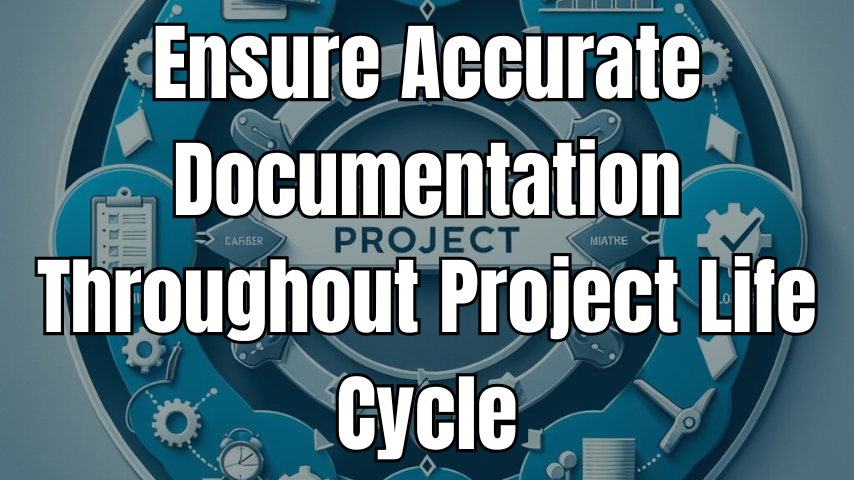Key Takeaways
- Accurate documentation is vital for project success.
- Each project phase requires clear and precise documentation.
- PDF tools ensure accessible and secure project documentation.
Accurate documentation is a very important aspect of project management. Documentation supports the realization of the project’s objectives and can be an effective means for stakeholders’ smooth internal or external communication. One can observe well-demarcated stages: initiation, planning, execution, monitoring, and closing which mark the life cycle of a project. Each phase of the project life cycle requires accurate documentation to ensure clarity and apt alignment about objectives, timelines, and deliverables.
Project Life Cycle Phases

Initiation: In the initiation phase, when starting a project, there is a requirement for a definition of the project scope and objectives. At this stage, the project managers gather requirements from stakeholders so that one can clearly understand what the project is set to achieve. This point in communications with stakeholders is where documentation is also a must-have, and it acts as a basis for documentation.
It is by creating a project charter that outlines major deliverables, timelines, and resource requirements that will see to it that all parties are aligned in their expectations and responsibilities. Documentation at this stage will avoid misunderstandings, and the project will set a good tone for success.
- Planning: Planning phase. Here, detailed plans and timelines are developed to guide the real execution of the project. At this stage, it breaks the entire project into manageable tasks and assigns resources as well as creates and sets milestones. Documentation also proves to be very crucial at this stage in setting clear expectations among team members and stakeholders. A project plan should comprise timelines, budgets, risk assessments, and communication strategies. Writing these aspects will ensure that everyone aligns and prevents wasteful delays and arguments in further stages of the project.
- Execution: The execution phase is where things take shape from project plans. Implementation of project plans and tracking progress are the most significant activities that occur in this stage. Documentation in real-time is very important now because this will enable teams to track change, tasking management, and necessary communication of updates. These will be possible with the use of project management software when documenting progress and issues. This will help in collaboration by ensuring that everyone knows their responsibilities. In this particular phase, proper documentation is important as deviations from the plan should be identified so that corrections should be done immediately.
- Monitoring and Controlling: Project managers appraise the performance of projects against the objectives set during the monitoring and controlling phase. They examine measures of progress, identify variances, and take corrective actions where necessary. It helps ensure that records are maintained accurately. This compliance is essential for reporting to stakeholders. They may require information on project status, risks involved, and resources being used. Proper documentation assists project managers in providing transparent and detailed reports. These reports help stakeholders make informed judgments and sustain confidence throughout the project.
- Closing: The closing phase is that which means a formal standpoint project completeness. It is marking the finalization of the project deliverables and ensuring all the documentation is complete. All project-related documents must be reviewed to ensure that they reflect the outcomes of the project and any lessons that were learned. Documentation of the insights and recommendations for future projects can therefore guide other teams involved in subsequent projects. This reflective practice is helping not only in the creation of organizational knowledge but also in continuous improvement within project management processes.
H1 Best Practices for Consistent and Effective Documentation
If such best practices put forth here are adopted by the project teams, then it would significantly support them in the documentation concerning increasing its accuracy along with effectiveness in their documentation processes so that their respective projects could be successfully accomplished.
A. Standardization of Documentation Formats
Standardized documentation formats ensure uniformity along with clarity when applied to all documents within the project. This encompasses uniform report and minute templates, as well as project plan templates, so the content gets better clarity and visibility for all the team members. Consistent formatting reduces confusion and increases collaboration by everyone being familiar with the layout and structure of the documents. Further, this standardized format may also help the process of documentation become more efficient as a whole because it makes it easier for people to understand what they must include.
B. Review and Updates
Documentation is expected to be treated as a living breathing thing, which means it must be reviewed from time to time throughout the life cycle of the project. Repeated reviews help identify discrepancies, outdated information, or gaps in any document. To ensure updates occur regularly, especially after significant meetings or milestones, establish a routine for updating documents. This ensures the team benefits from current information. It also promotes continuity in the project and accountability. Each individual is responsible for checking the records in their assigned area.
C. Collaboration Tools for Team Communication
Collaborative tools are highly essential and can improve communication among the team members, thus making it easier to document. It allows the teams to work on tasks with less restriction of locations. These tools provide instant feedback and support discussions. They reduce the chance of mistakes and ensure accurate documentation of all contributions. By integrating collaboration tools into the workflow, teams can improve transparency. At the same time, this approach fosters a culture of open communication.
D. PDF Tools Integration
The use of PDF tools will significantly enhance the accuracy of and access to project documentation.
- Editing for Clarity and Consistency: With PDF editing tools, one can make the appropriate adjustments to documents so that the reader will know what he or she is reading accurately. This way, a document always comes out professionally looking and readable.
- Merging Project Files Containing Relevant Content for Entire Reports: This can be done, for instance, by consolidating several documents into one PDF file. It’s used in creating comprehensive reports. As a result, the process of distributing them to stakeholders who need the document can be streamlined through this one format.
- Divide Unmanageable Documents into Sections for Easier Navigation: Squeeze extensive information into smaller, more readable portions. By doing so, members on the team easily find what they need with minimal digging through large volumes of text.
- Conversion of Files to PDF: Universal Readability and Security Converting files into a format like PDF ensures readable consistency on different devices and platforms. In addition, PDF files also offer password protection and watermarking features, enhancing the security of the documents containing sensitive information.
The Ending Note
Accurate documentation is fundamental to the success of projects throughout their life cycle. Each phase requires careful and precise documentation to ensure clarity, alignment, and accountability among all stakeholders. By adopting best practices project teams can significantly enhance the accuracy and effectiveness of their documentation processes. Maintaining thorough and accurate documentation is key to the success of projects. It also helps build stakeholder confidence.



